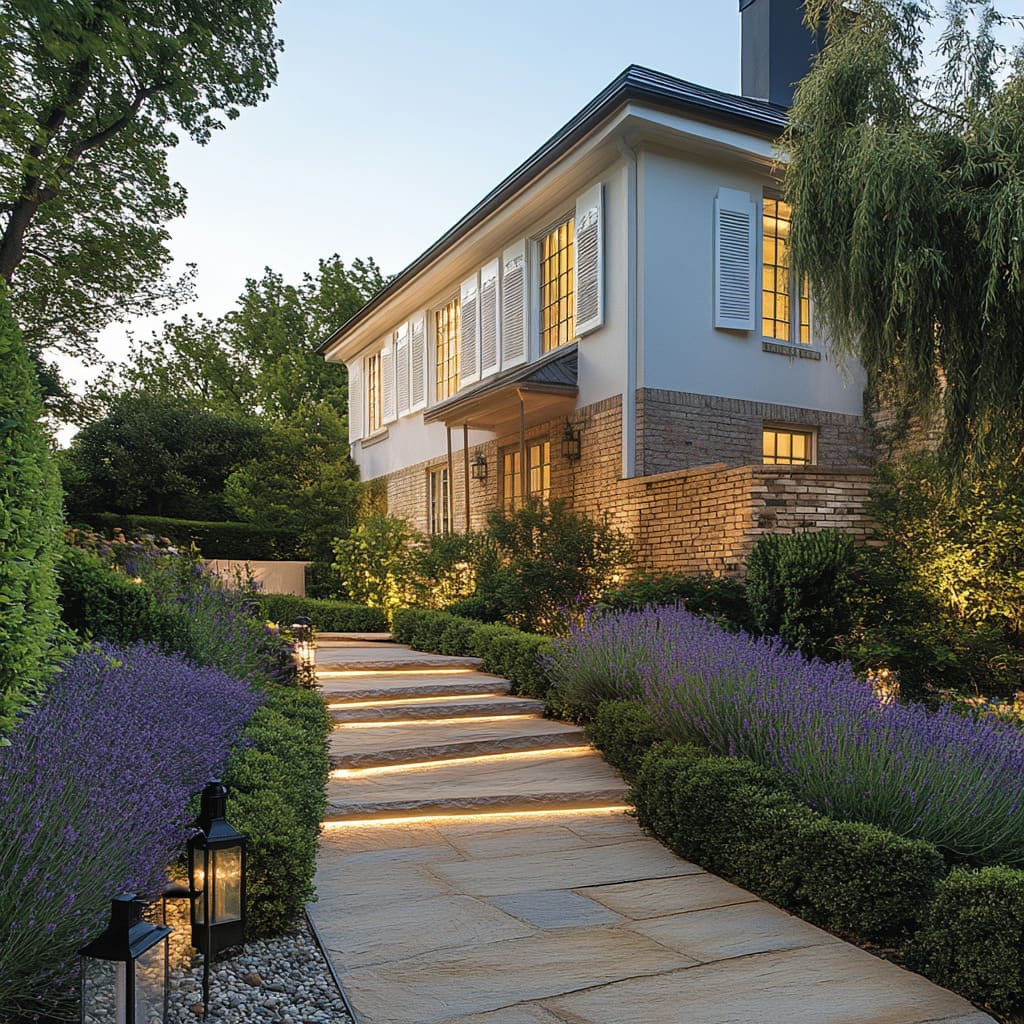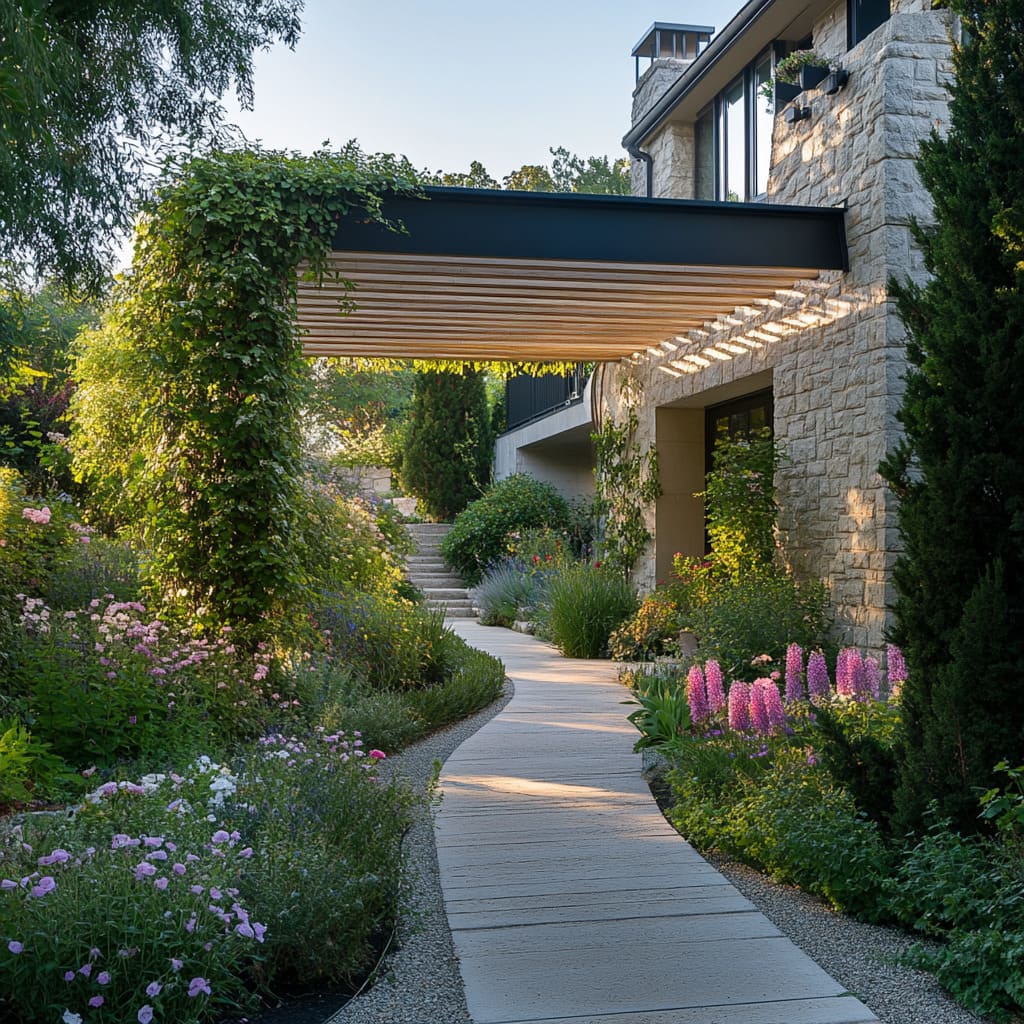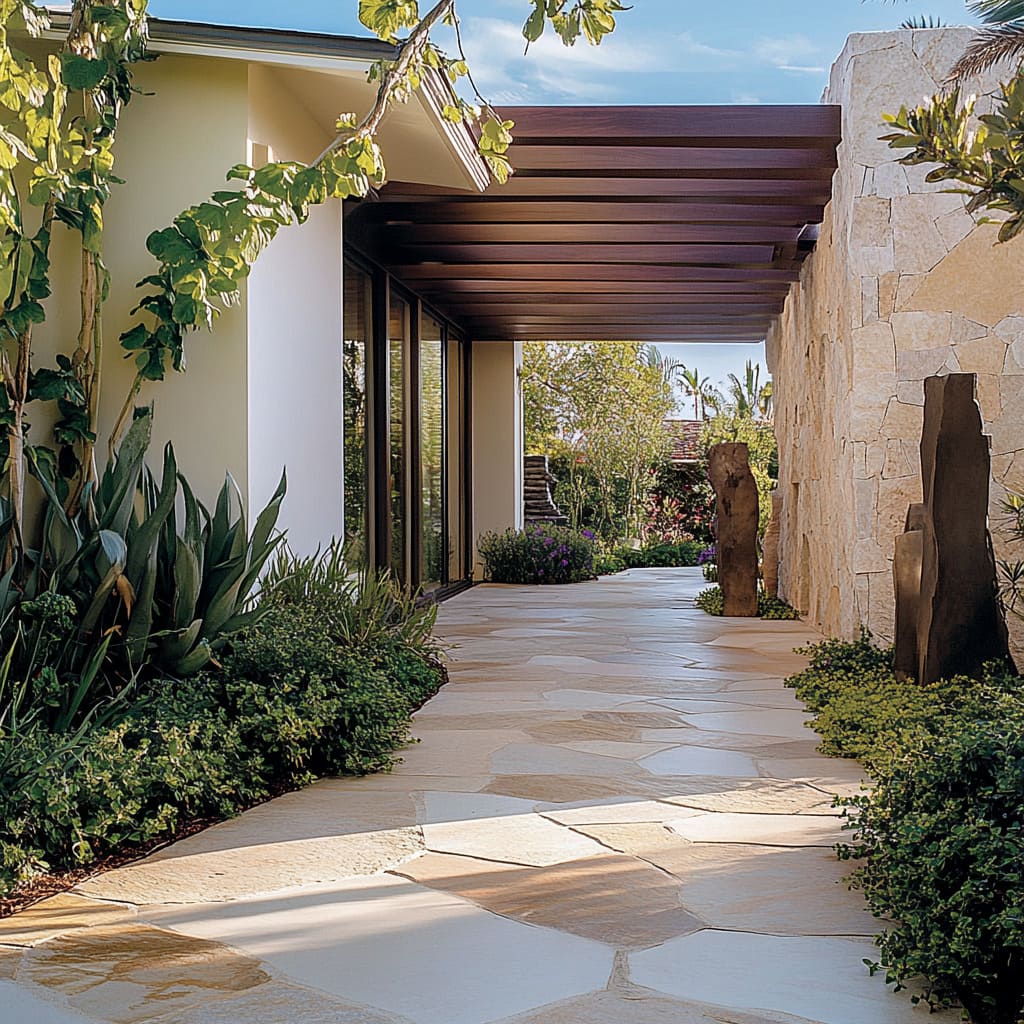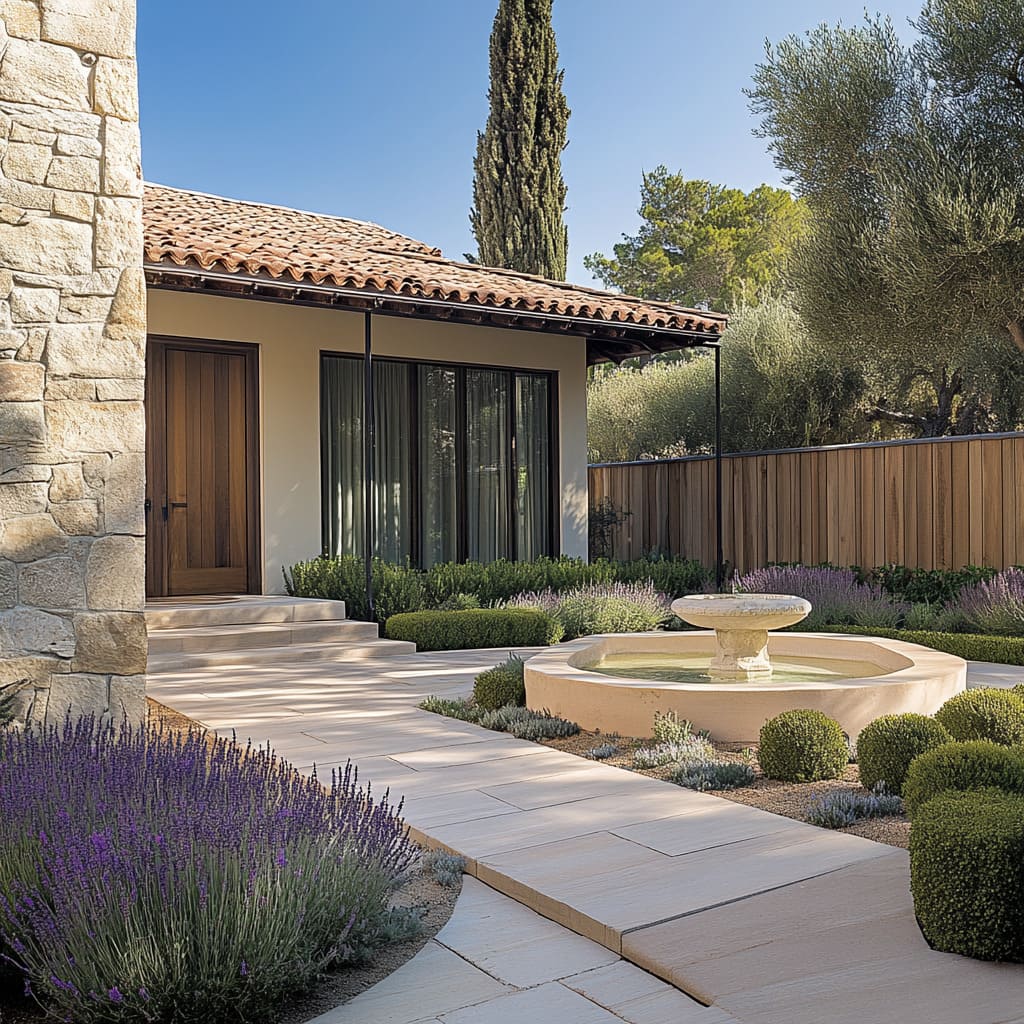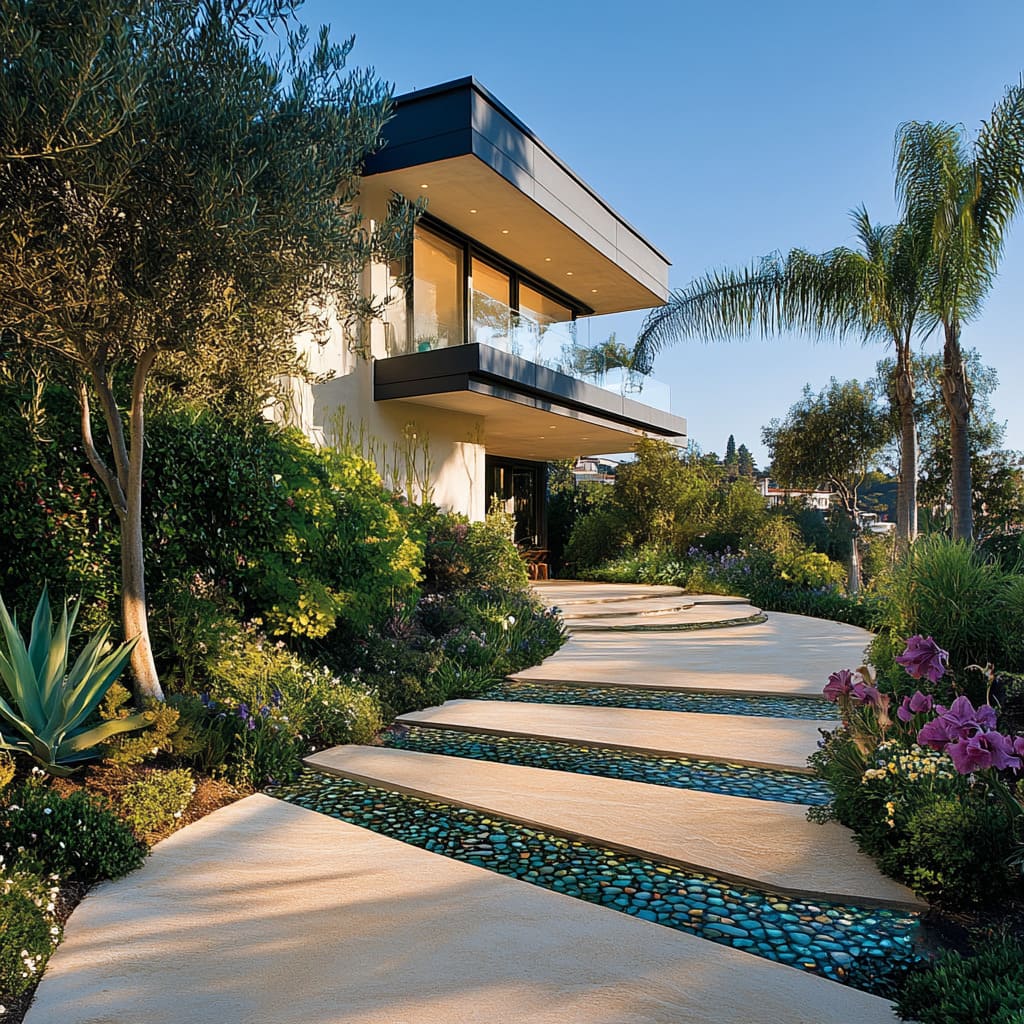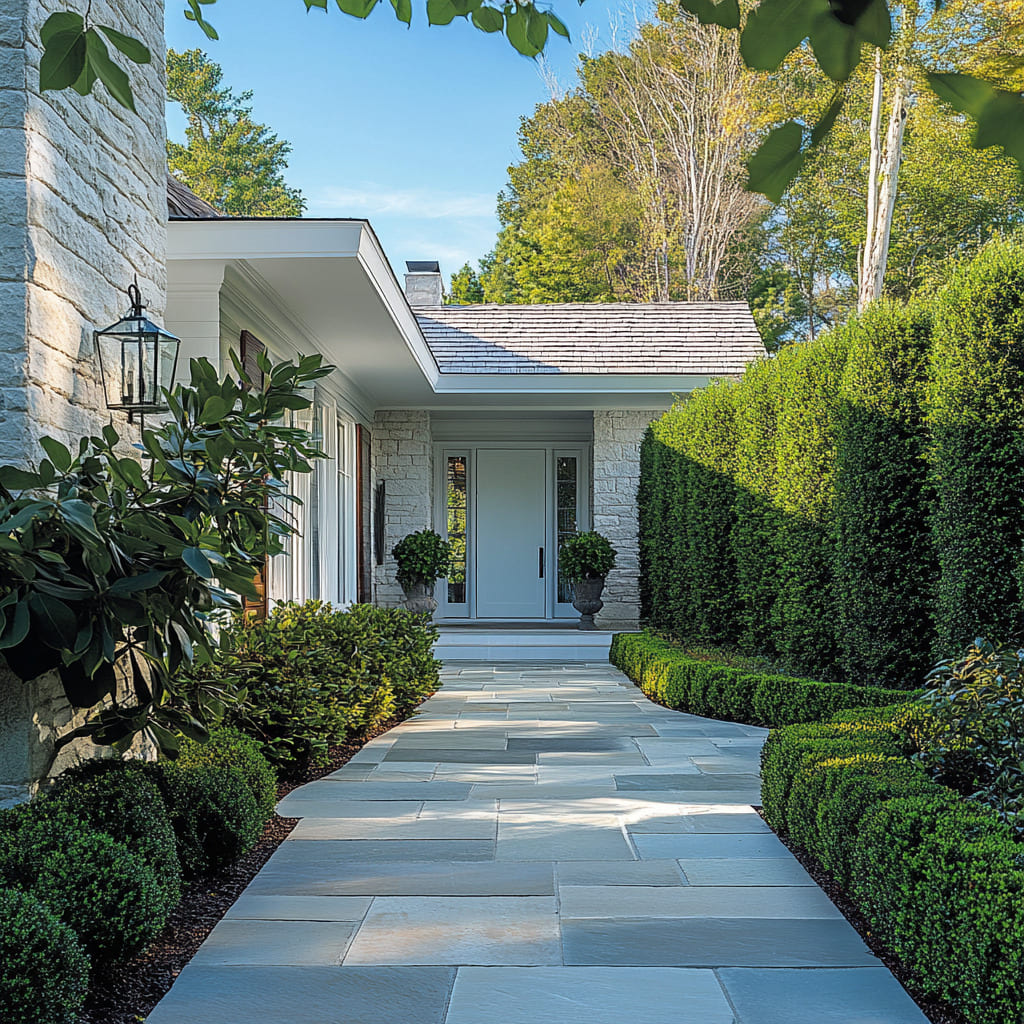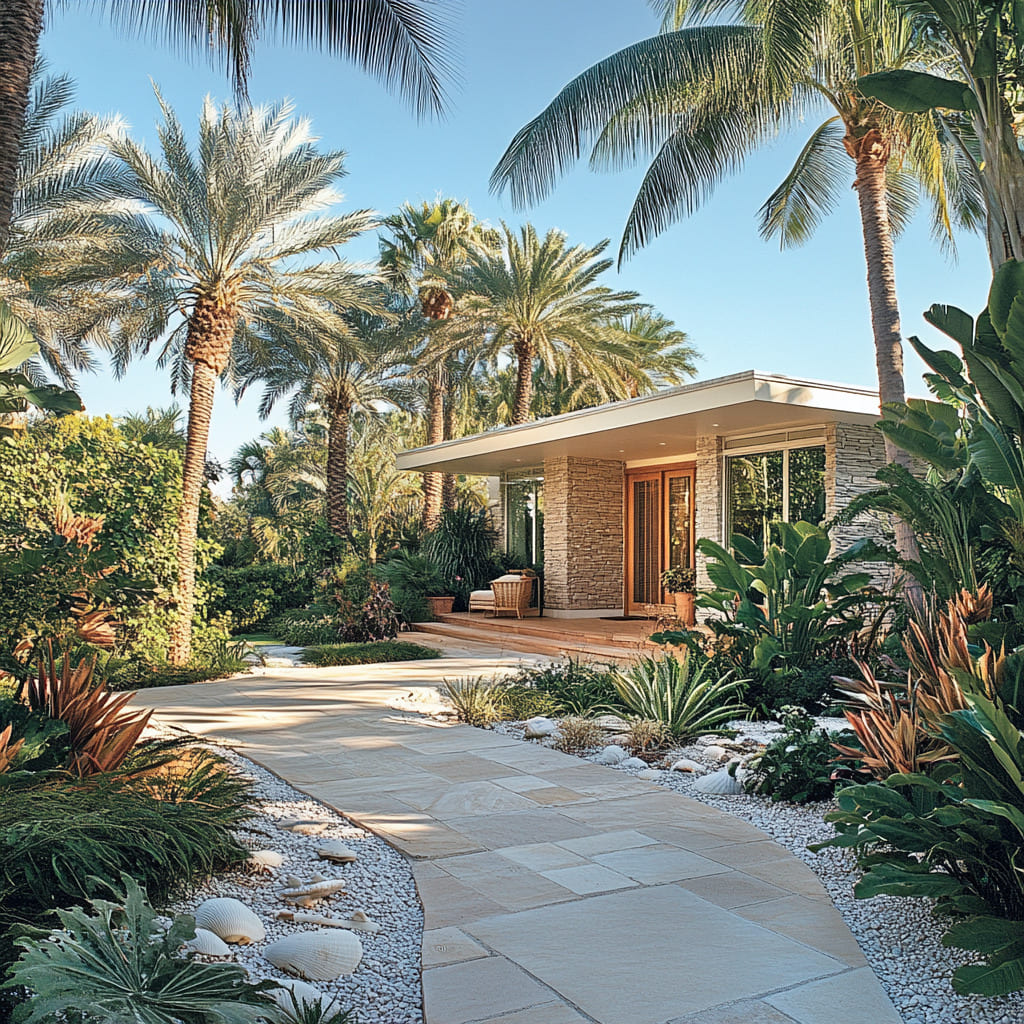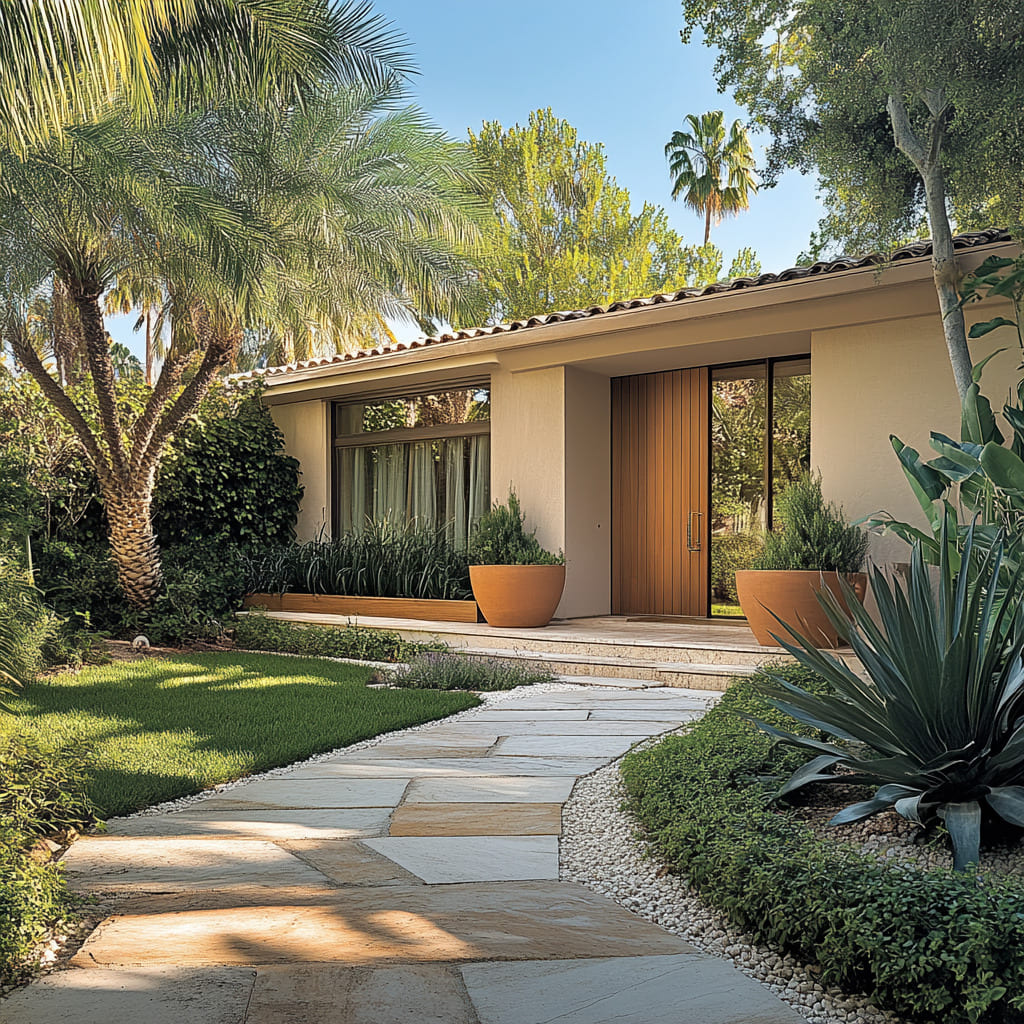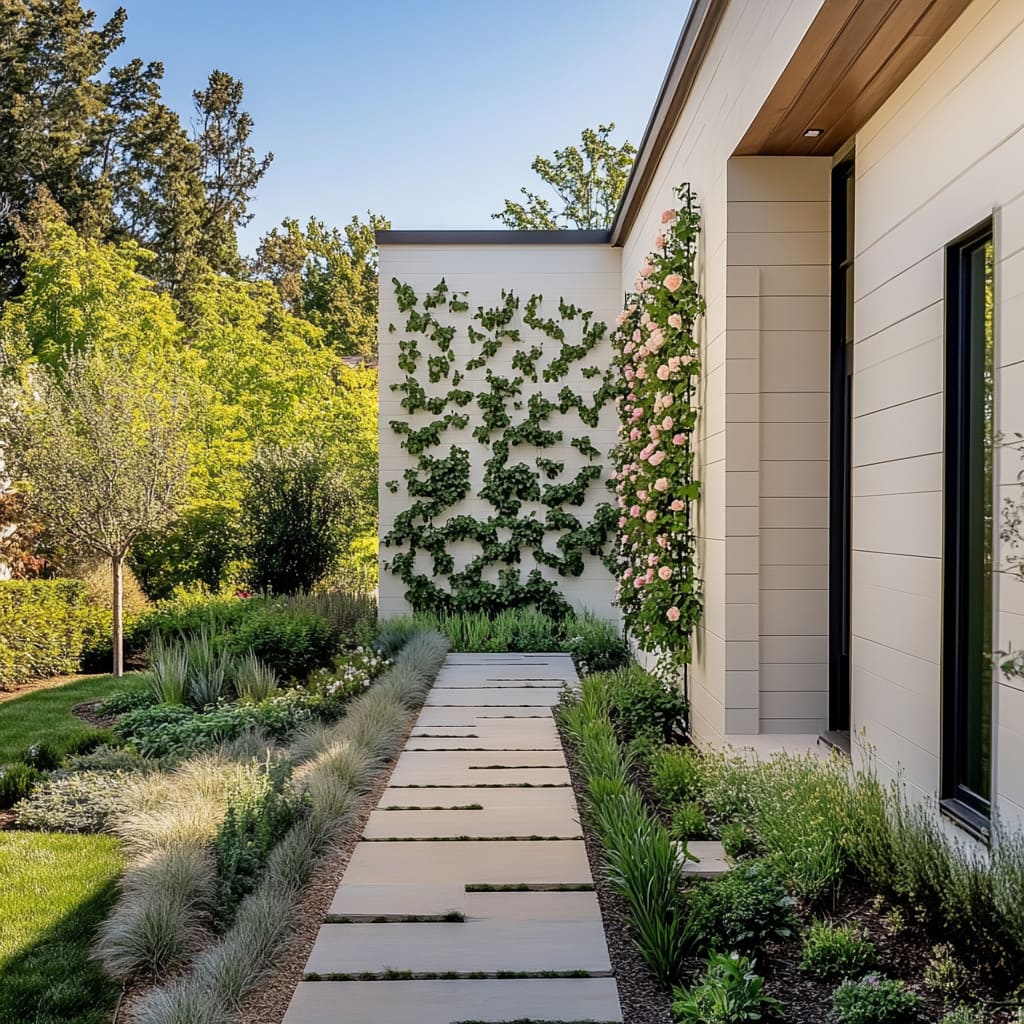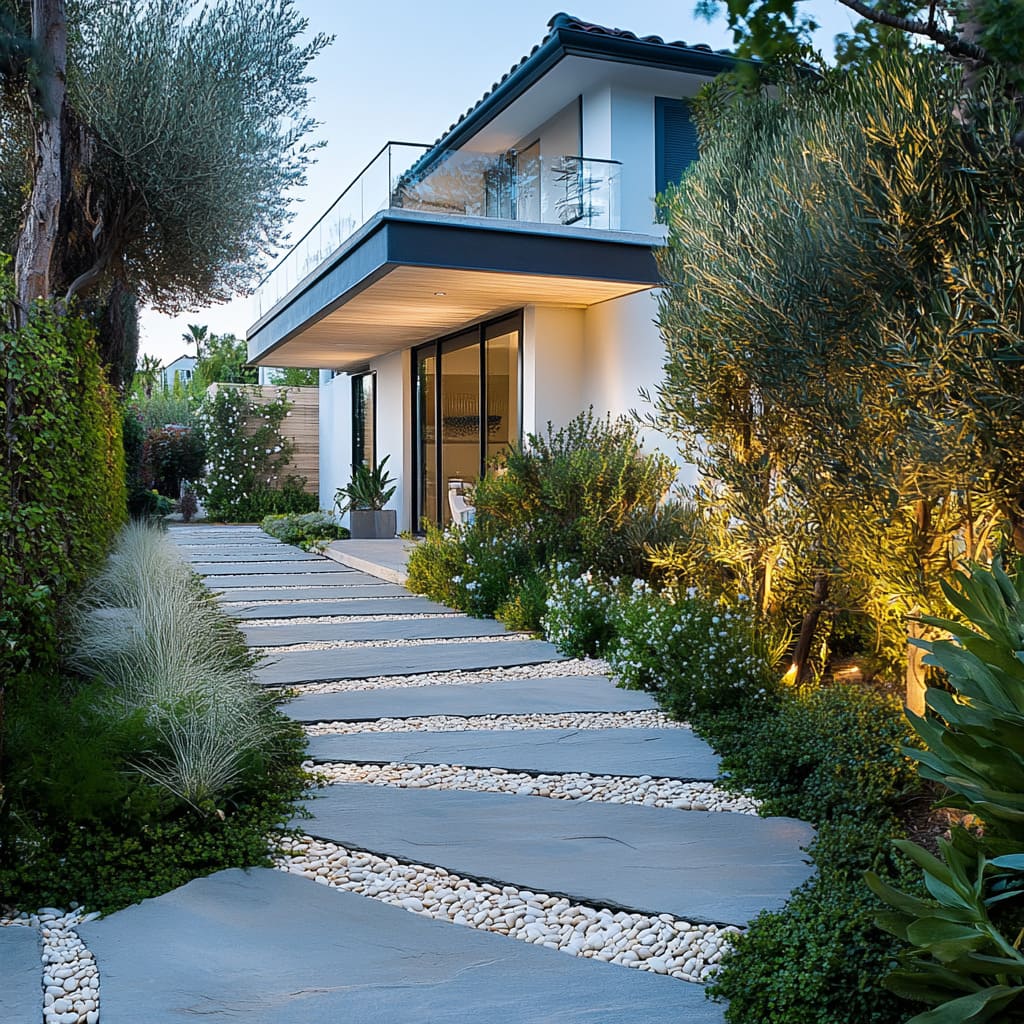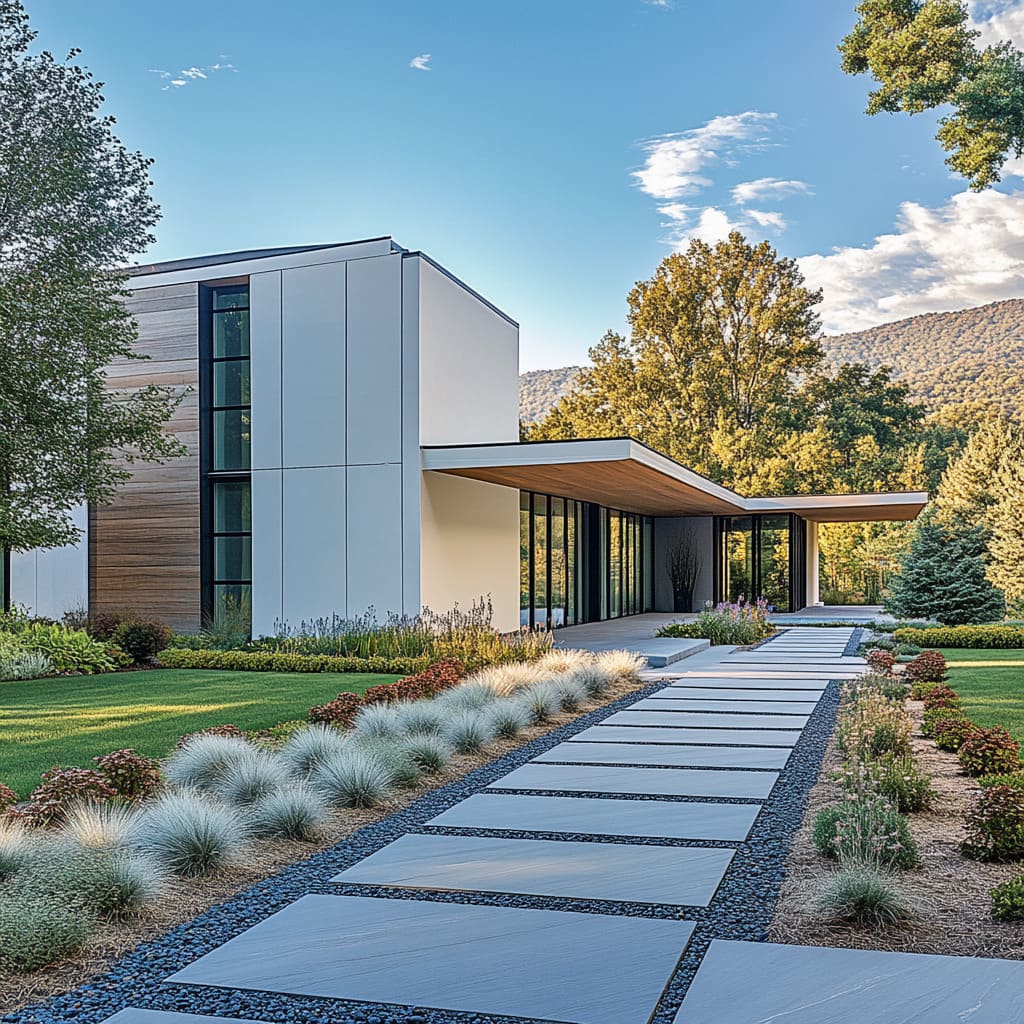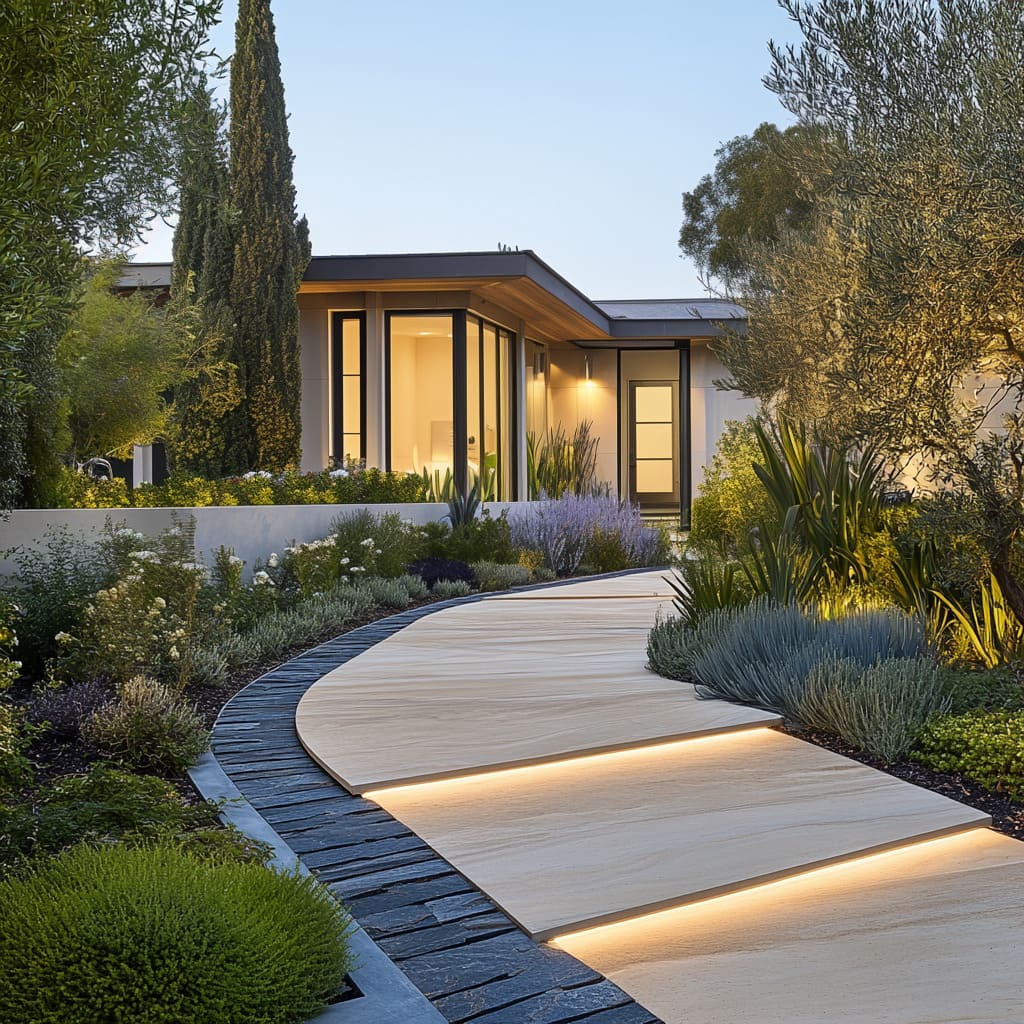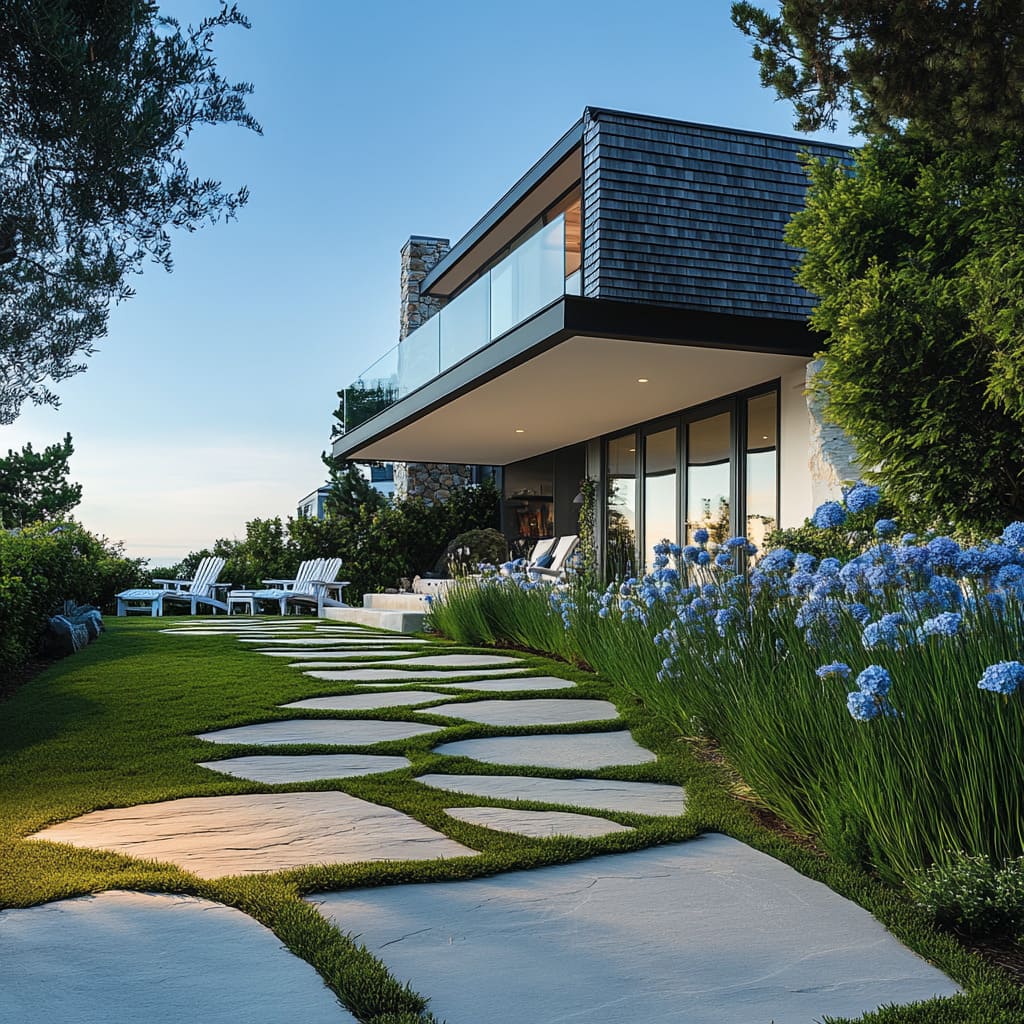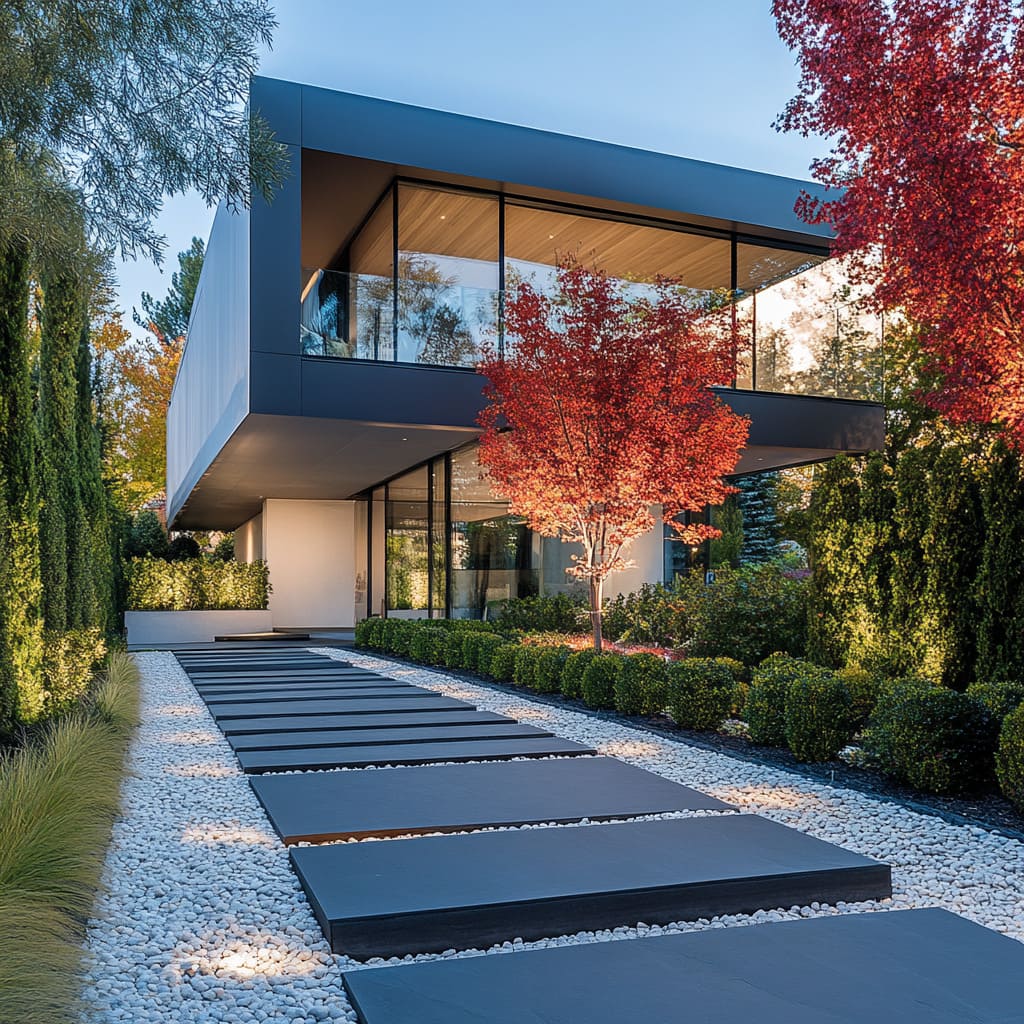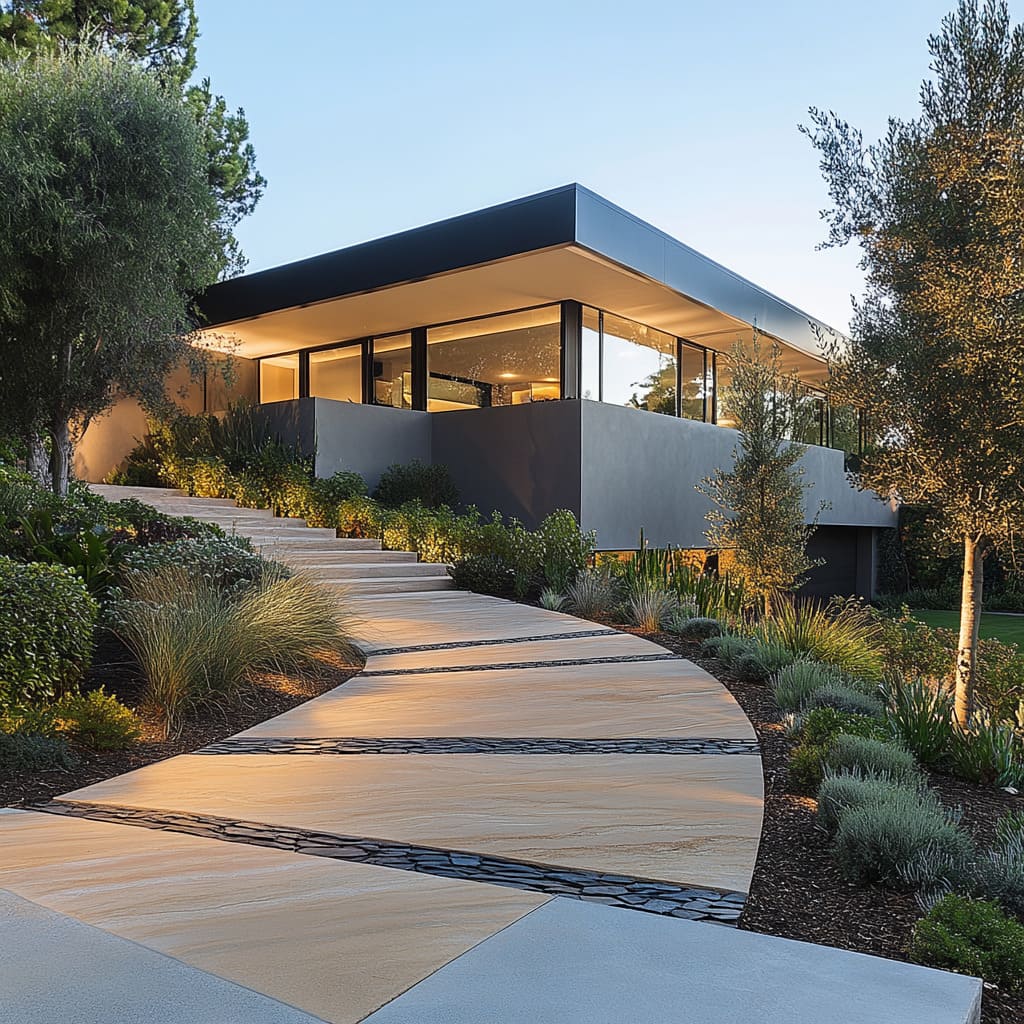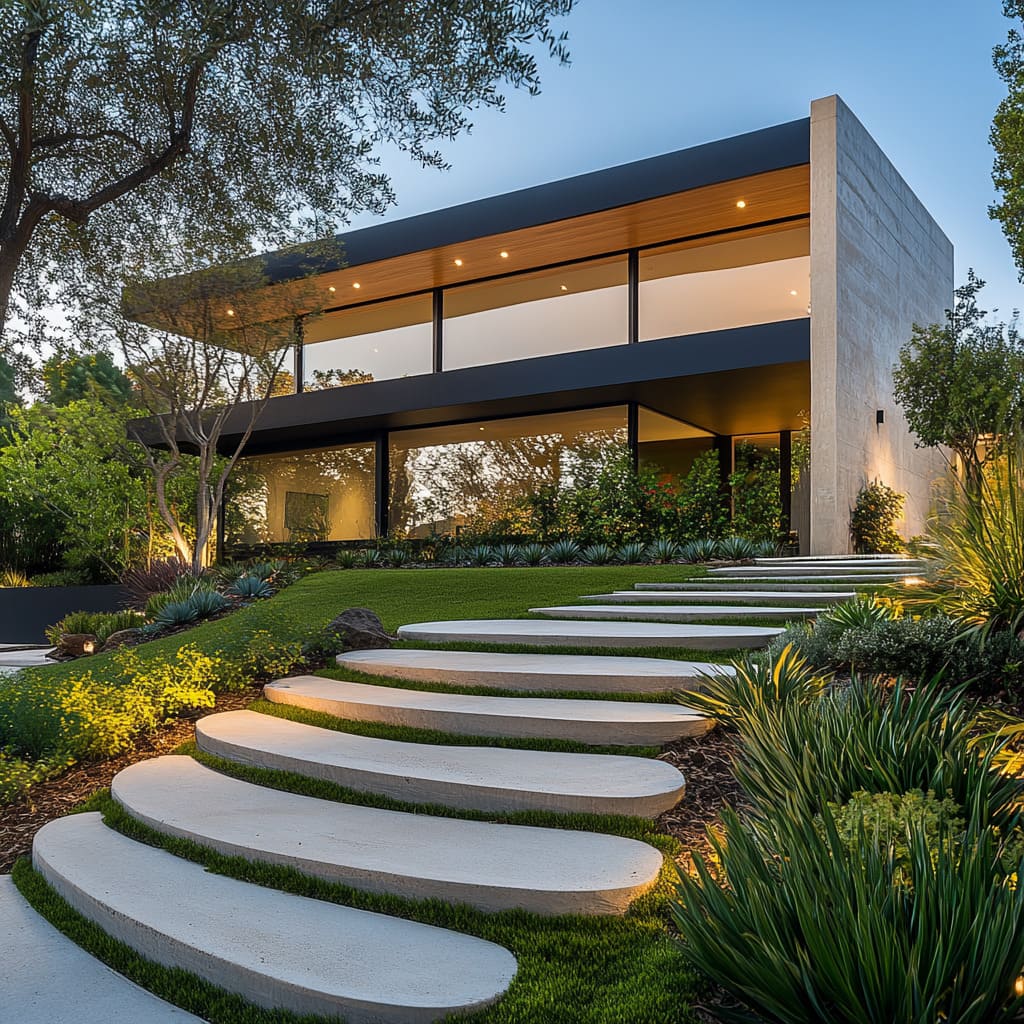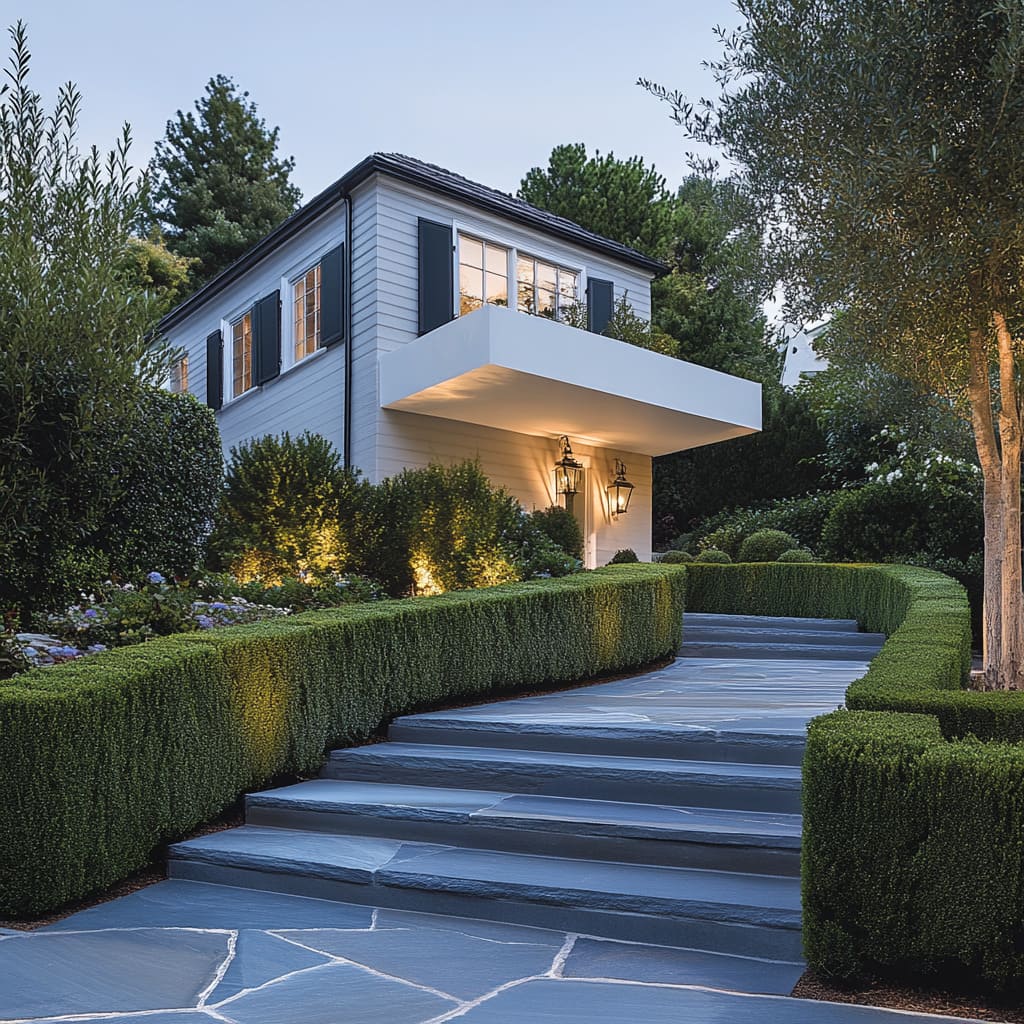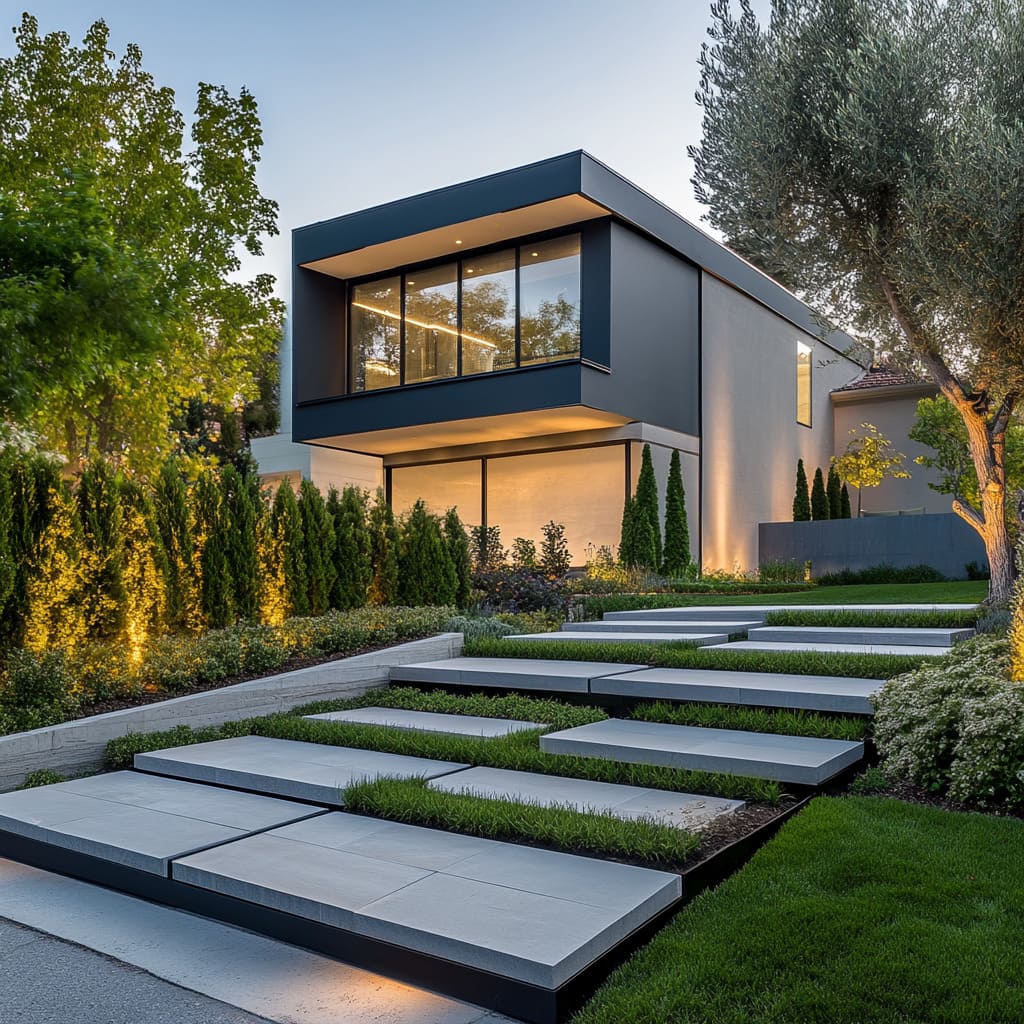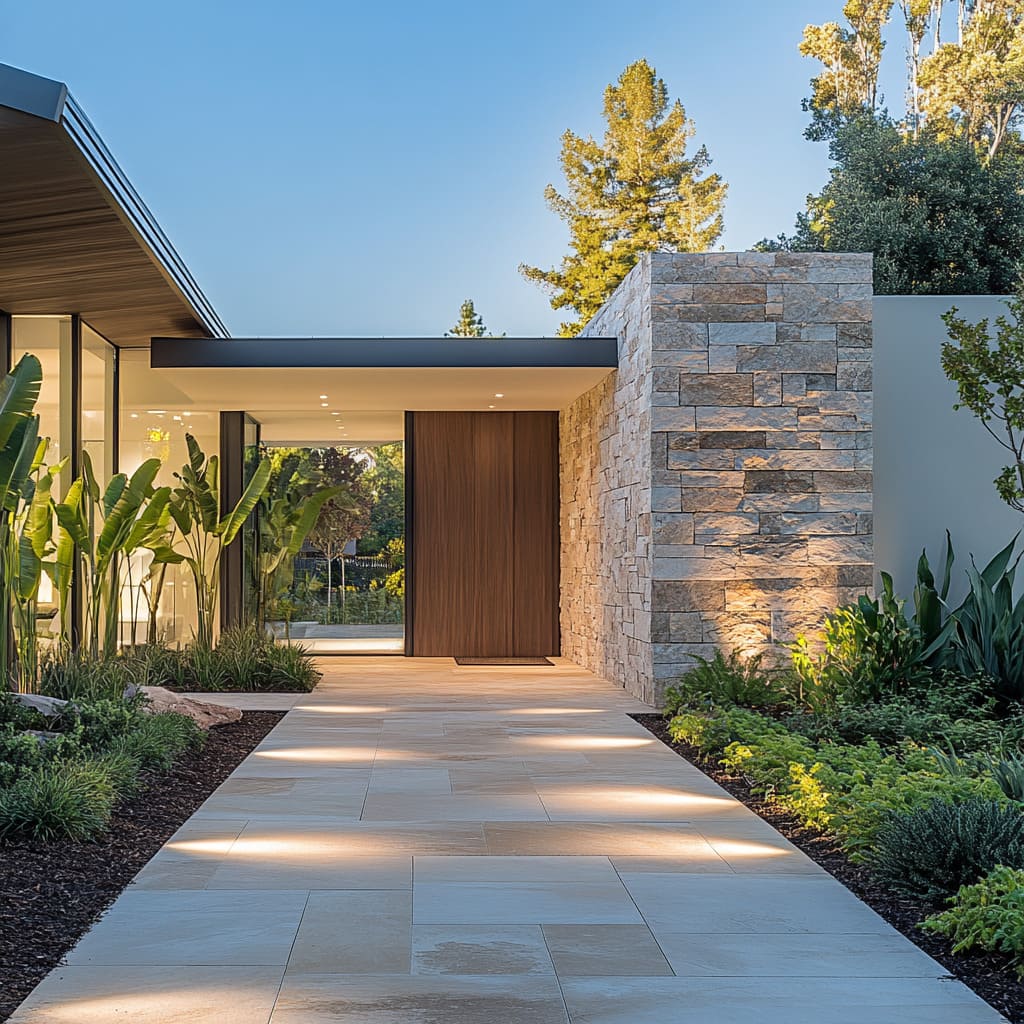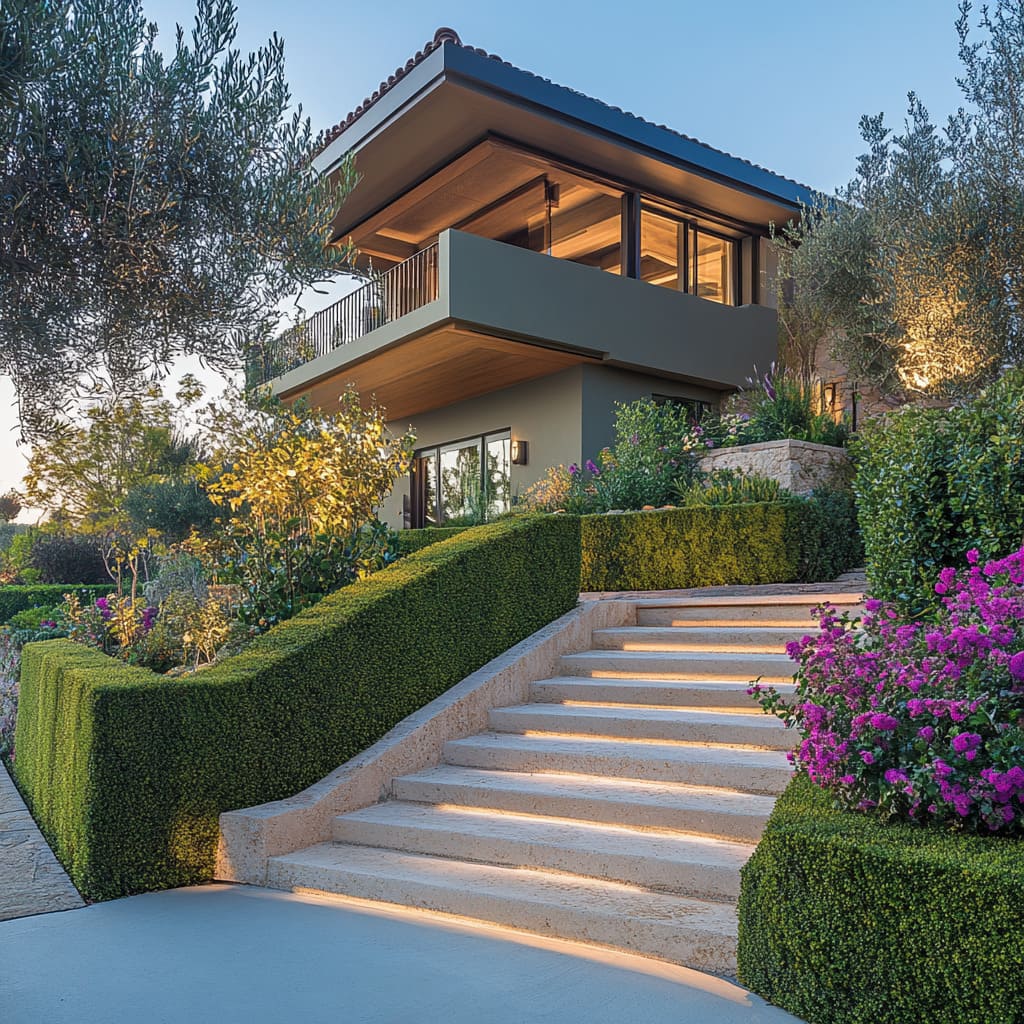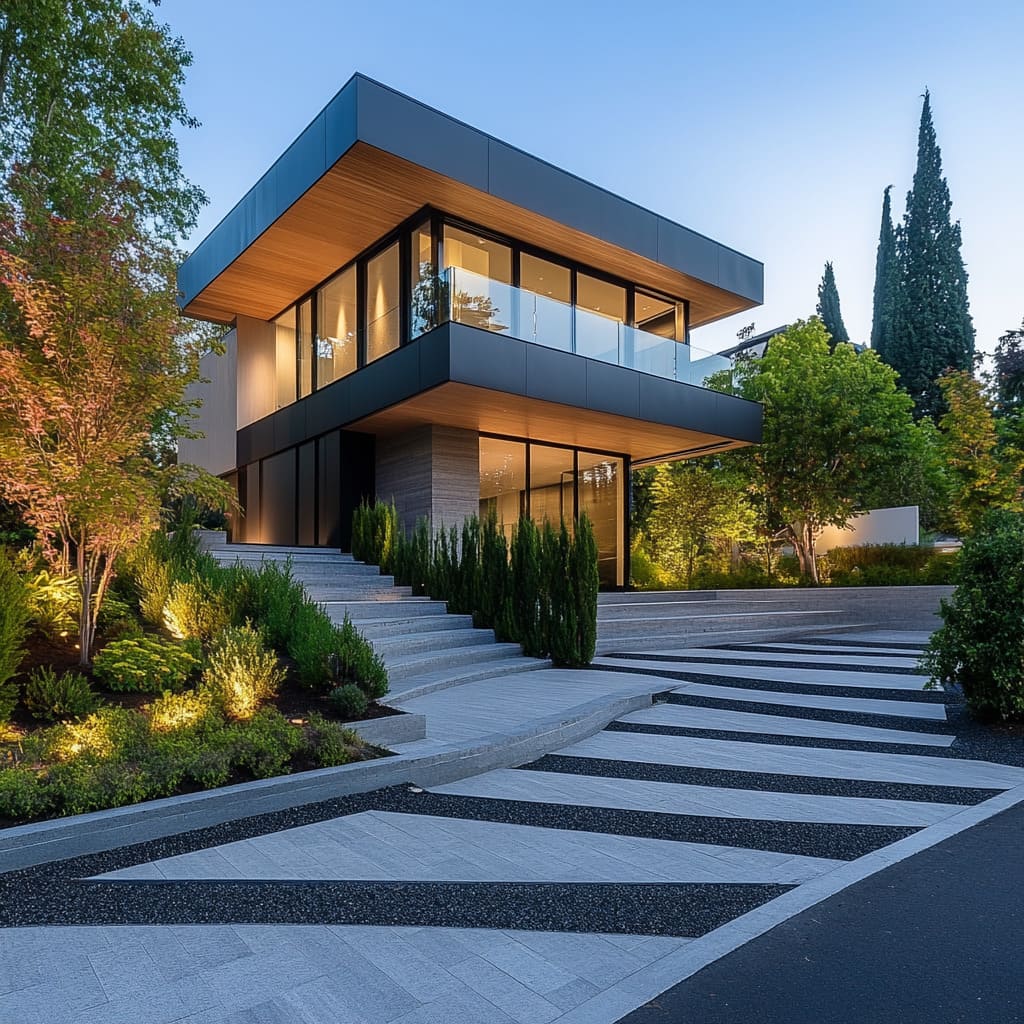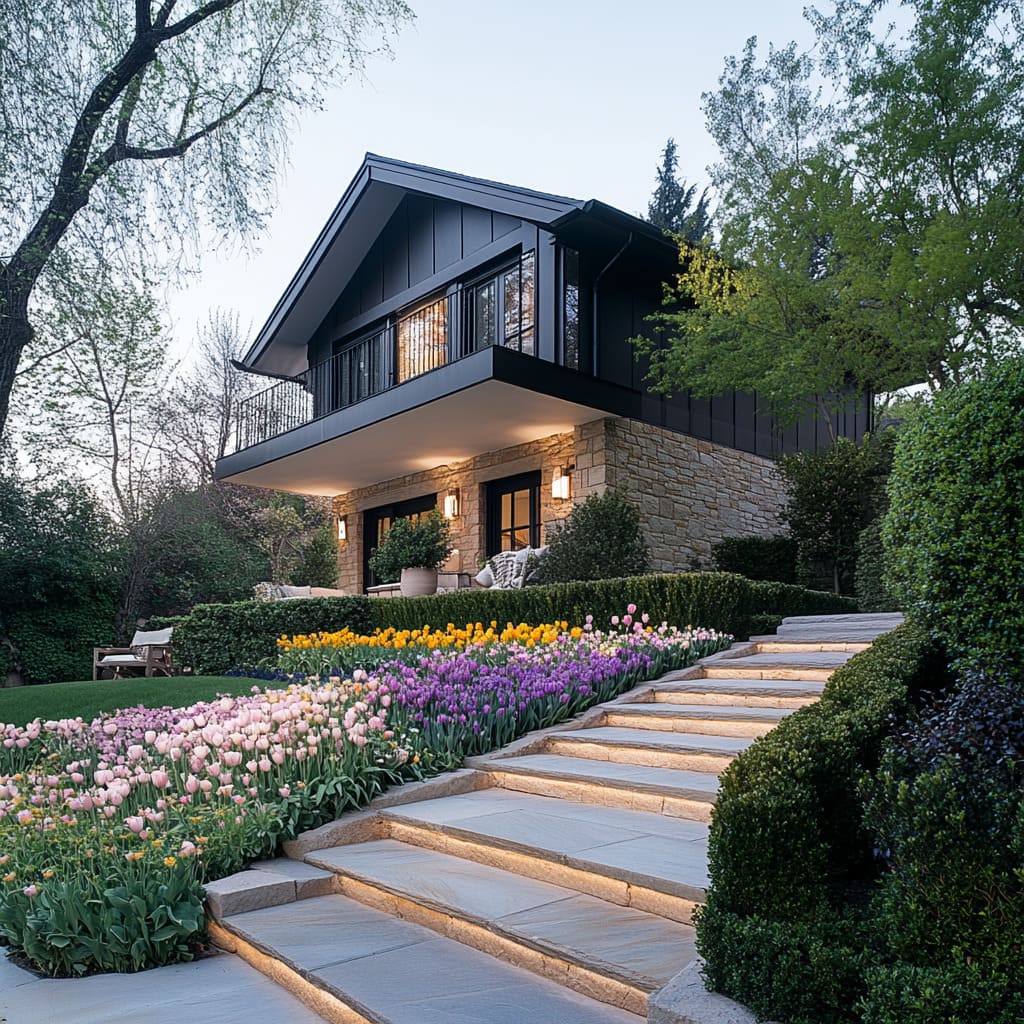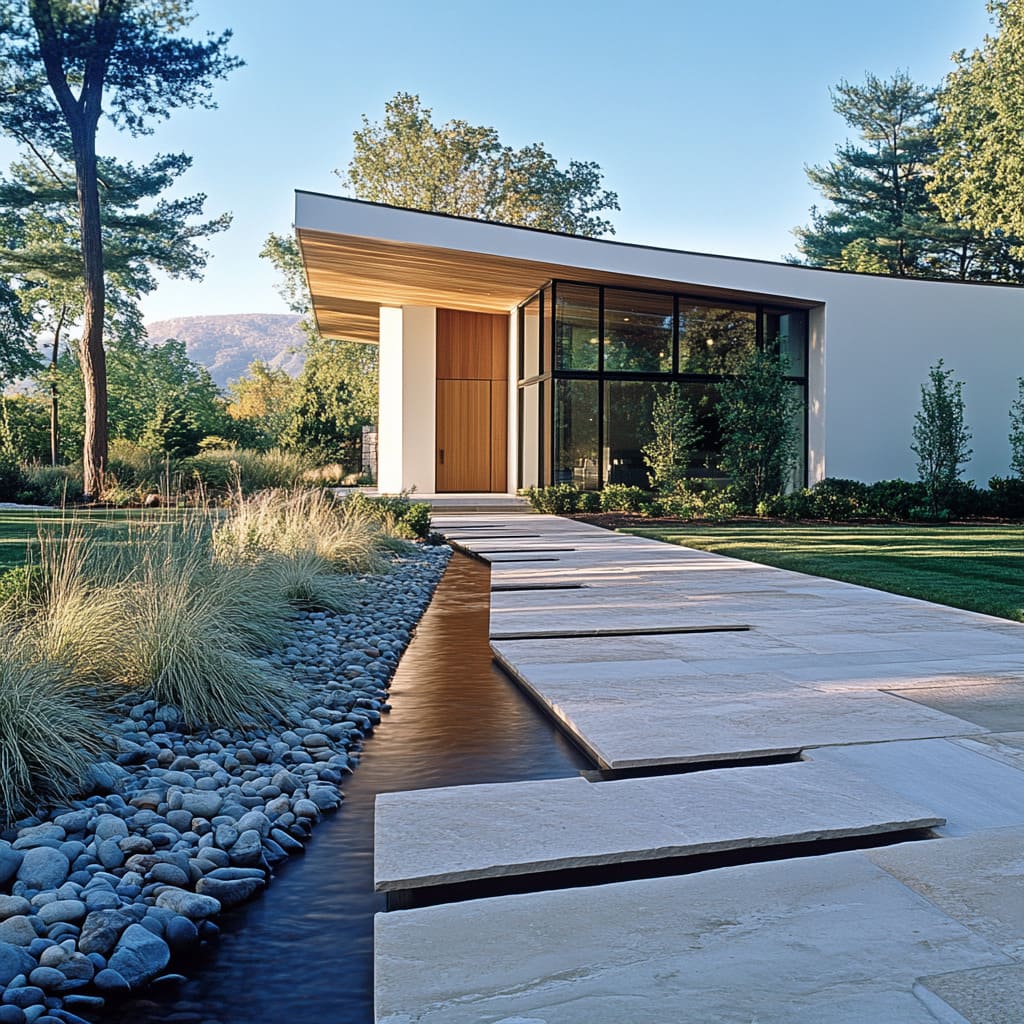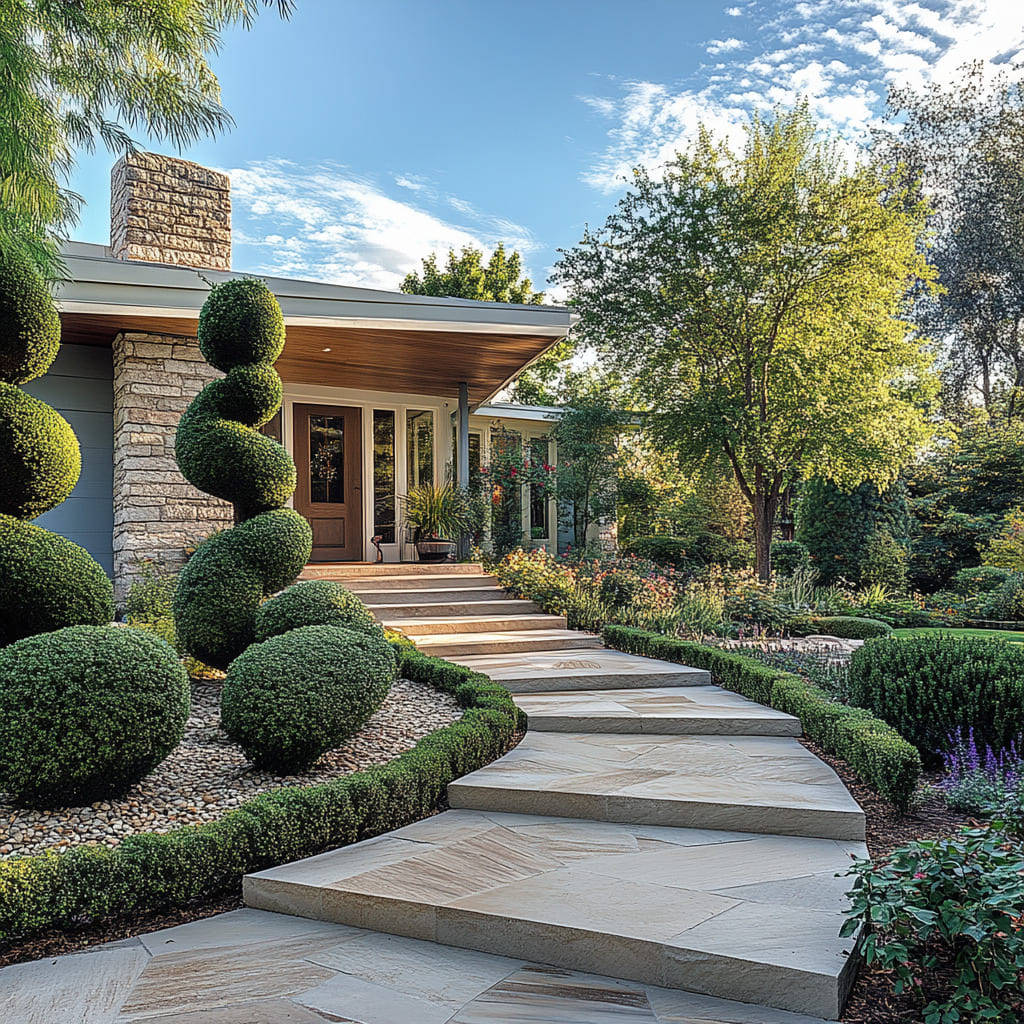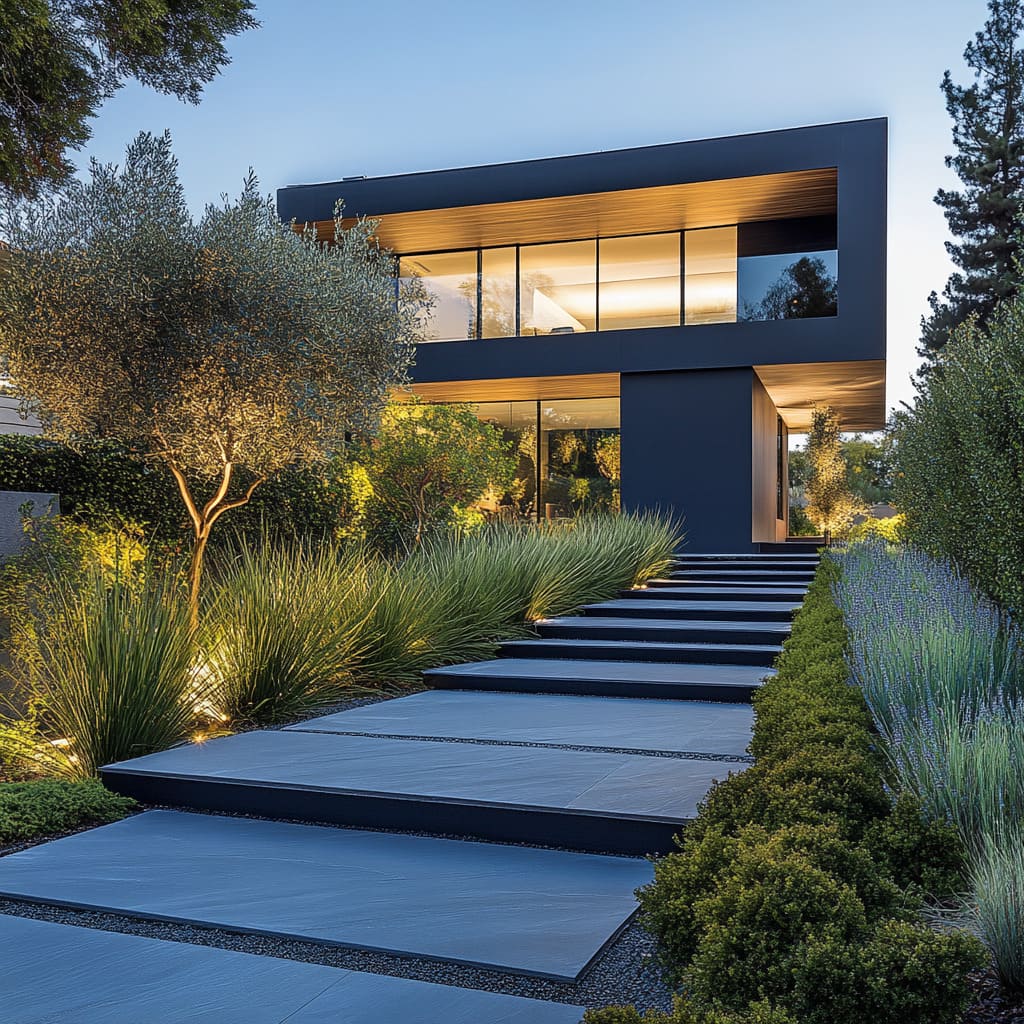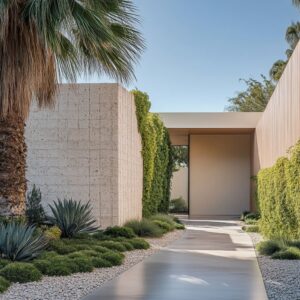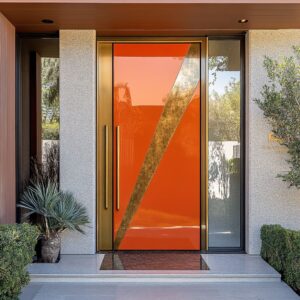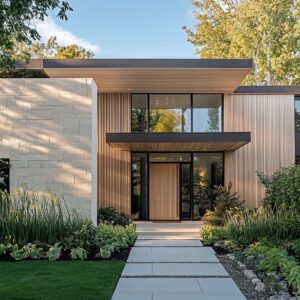The front walkway is an opportunity to create a warm, inviting first impression while showcasing your personal style. With the right design, your walkway can seamlessly blend with your home’s architecture and landscaping, becoming a central element of curb appeal.
Whether you’re drawn to modern minimalism, lush greenery, or classic charm, the possibilities are endless when exploring front walkway landscaping ideas. By carefully choosing materials, plants, and lighting, you can design a pathway that not only looks beautiful but also feels like a natural extension of your home.
Materials and Textures in Modern Walkway Designs
When it comes to creating a memorable first impression, the choice of materials and textures in a walkway is crucial. It sets the tone for the entire front yard, blending hardscape with landscaping while adding depth and character to the overall design.
Let’s explore how sandstone and bluestone variations as well as concrete and grass pairings are transforming walkway ideas for the front of house.
Sandstone and Bluestone Variations
Subtle color gradients in sandstone and bluestone provide a refined charm to front yard pathways. These natural stones often showcase gentle tonal shifts—think pale beige transitioning into cool gray or light blue undertones.
This play of colors prevents a walkway from feeling monotonous, making each step along the path visually engaging. The result is a design that feels dynamic, even in its stillness, and provides a sense of movement through texture.
Contrasting joints and inlays are another hallmark of modern stone walkways. Designers often separate slabs with gravel or pebble inlays, which serve both functional and aesthetic purposes.
These inlays define the boundaries of each stone, emphasizing the precision of the layout. In curved walkways, pebbles enhance the flow of the design, drawing attention to the elegant sweep of the path.
For linear pathways, they reinforce the clean, structured look by sharpening the edges of each slab.
The choice between flagstone irregularities and rectangular slabs plays a significant role in determining the tone of the design. Irregularly shaped flagstones create a more natural, casual aesthetic, mimicking the organic feel of traditional gardens.
On the other hand, rectangular slabs exude a sense of clean modernity. For an intriguing blend, some designs pair regular-shaped stones with pebble inlays, striking a balance that feels thoughtfully composed.
This combination achieves visual tension, adding layers of interest to the walkway without overwhelming the surrounding landscape.
Concrete and Grass Pairings
For contemporary styles, concrete and grass pairings offer a sleek yet natural approach to front yard walkways. The alternating use of concrete pavers and grass strips creates a checkerboard or floating effect that feels fresh and bold.
Here, the grass acts as negative space, framing the concrete and emphasizing the crisp geometry of the design. This combination seamlessly integrates modern hardscape with lush greenery, ensuring the walkway doesn’t feel overly stark.
Tiered designs take this concept further, with broad concrete steps interspersed with thin turf accents. These grassy ribbons not only soften the edges of the concrete but also serve as living dividers, connecting the walkway to the surrounding landscape.
This approach works particularly well in sloped yards, as the tiered structure adds dimension while maintaining an approachable aesthetic. The subtle play between solid and living textures turns the walkway into more than just a functional path—it becomes a dynamic element of the home’s exterior.
Whether you’re leaning toward the timeless appeal of sandstone and bluestone or the clean lines of concrete and grass, these materials and textures offer endless possibilities for modern walkway ideas for the front of house. From color gradients to thoughtful pairings, every choice contributes to a design that not only enhances the home’s curb appeal but also feels like a seamless extension of the landscape.
By blending natural elements with modern structures, these walkways create spaces that feel as welcoming as they are visually striking.
Lighting Methods and Their Design Roles
Lighting plays an essential role in defining the look and functionality of a walkway, offering both aesthetic charm and practical benefits. From enhancing safety to creating focal points, thoughtful illumination transforms even the simplest pathway into a feature of the landscape.
Let’s take a closer look at how edge illumination and focal lighting can work together to inspire creative ideas for a front walkway.
Edge Illumination and Step Safety
Recessed lights in steps are a subtle yet highly effective way to enhance both safety and ambiance. These lights, often installed at the risers, cast a gentle glow across the step surface, ensuring visibility while maintaining a clean and modern aesthetic.
In walkways with curved or tiered steps, recessed lighting emphasizes the contours, adding depth and dimension to the design. The soft light not only guides the way but also draws attention to the sculptural quality of the steps, making them a visual focal point.
Another key technique is perimeter ground lighting, which involves placing small fixtures along the outer edges of a pathway. This method works particularly well in gardens with dense plantings, as the light reflects off surrounding leaves, creating a dynamic interplay of shadows and highlights.
On stone walkways, the reflections bring out textures and subtle variations in the material, ensuring that the design is appreciated even after sunset. Whether used in straight paths or winding layouts, edge illumination creates a defined boundary that subtly frames the walkway.
Focal Lighting
For those seeking a dramatic effect, focal lighting is an excellent way to draw attention to standout elements in the landscape. Directional spotlights, for example, can be used to highlight a vibrant tree, a carefully shaped topiary, or a water feature near the path.
By spotlighting these elements, the lighting design encourages visitors to follow the walkway, subtly guiding their gaze while emphasizing key features of the yard. It’s not just about lighting the path but about integrating the walkway into the overall composition of the space.
To achieve a cohesive look, many designs incorporate a soft glow that blends with the architecture of the home. Warm soffit lighting, often placed above entrances or along the walls, creates a welcoming atmosphere.
When walkway lighting uses similar tones, the effect is harmonious, tying the exterior design elements together. This approach ensures that the path feels like a natural extension of the home, balancing practicality with style.
Final Thoughts on Lighting Design
Lighting methods, when thoughtfully applied, transform pathways into much more than functional routes. Techniques like recessed step lighting and perimeter illumination ensure safety while enhancing visual interest.
At the same time, focal lighting brings attention to key elements, ensuring the walkway becomes an integral part of the landscape design. Whether you’re looking for ideas for a front walkway that prioritize safety, aesthetics, or both, these lighting methods offer endless possibilities to elevate the charm and usability of your outdoor spaces.
Interplay of Shapes and Layout
When designing a walkway, the choice of shapes and layout plays a central role in creating not just a functional path but an engaging visual narrative that reflects the home’s style and landscape. The contrasts between curved and straight pathways, and the options for incorporating multiple levels, give homeowners and designers the flexibility to craft a look that perfectly complements their outdoor space.
Curved vs. Straight Pathways
Curved walkways bring a sense of fluidity and natural rhythm to the landscape. These designs are particularly well-suited to softer, organic environments like tropical gardens or Mediterranean-inspired yards.
The curves echo the irregular shapes of lush greenery, flowering shrubs, or flowing water features, blending effortlessly into the surroundings. A notable feature of curved paths is how they allow portions of the yard to remain hidden as you approach the house.
This gentle “reveal” effect adds an element of intrigue and privacy, as the path winds through carefully curated plantings before leading to the entrance. In contrast, straight, linear pathways offer a bold and structured statement, making them a popular choice for minimalist or modernist homes.
These walkways create an uninterrupted visual connection from the street or driveway to the front door, emphasizing the geometric architecture of the house. The crisp, clean lines are ideal for homes with strong symmetry or angular design elements, as they echo the same sense of precision.
Straight paths are also a practical choice for smaller spaces, where their simplicity enhances the sense of order and efficiency in the layout.
Multi-Level or Tiered Approaches
For properties with uneven terrain or natural slopes, stepped transitions are an effective way to integrate a front yard pathway into the landscape. By breaking up the elevation into manageable levels, steps can create opportunities for added visual interest.
For example, incorporating small retaining walls alongside the steps allows for the inclusion of terraces filled with colorful plants or neatly trimmed hedges. These layered elements can visually expand a compact yard, giving the impression of depth and grandeur.
Whether bordered by vibrant flowers or subtle grasses, tiered pathways bring a dynamic, sculptural quality to the overall design.
On the more contemporary end of the spectrum, floating pathway illusions add a strikingly modern touch. This approach involves spacing the individual slabs of the walkway over a base material, such as river rocks, mulch, or even a shallow water feature.
The result is a visual break between each segment, which can make the slabs appear as though they are hovering above the ground. Incorporating water elements, whether static or flowing, enhances the sensory experience by engaging both sight and sound.
This design technique is especially impactful in modern settings, where the clean lines and dramatic effect perfectly complement the sleek aesthetic of the home. When it comes to shaping a path, the interplay between curves, straight lines, and elevation changes can completely transform the personality of a yard.
Curved paths invite exploration, while straight ones bring clarity and structure. Multi-level or floating designs introduce an architectural quality that blends beauty with functionality.
Each of these approaches offers inspiring front yard pathway ideas for creating outdoor spaces that are as welcoming as they are visually captivating.
Coordinated Plant Selections
Choosing the right plants to complement a walkway is as much an art as it is a science. The interplay between the height, texture, and thematic style of the greenery surrounding a path determines how well the landscape aligns with the house’s architectural character.
The right choices can make pathways feel cohesive and intentional, turning them into integral features of the outdoor space.
Plant Height Gradations
One of the most impactful strategies for planting along a walkway is the thoughtful use of plant height variations. This layered approach not only adds depth but also guides the eye naturally toward the home’s entrance.
Tall flanking greenery serves as a powerful design tool to create a natural “corridor” effect. For instance, towering palms or stately conifers positioned along a pathway can lead visitors toward the front door in a visually dramatic way.
When placed symmetrically, these elements establish a grand, formal atmosphere. Alternatively, tropical landscaping—featuring palms, banana plants, or large-leafed greenery—can imbue the path with a relaxed, inviting energy.
The combination of lush vertical height and curved paths often evokes a sense of escape, reminiscent of a secluded retreat. Low borders, on the other hand, bring structure and neatness to a walkway without overwhelming it.
Shaped shrubs, like boxwood or dwarf hedges, provide crisp edges, visually defining the boundary between the path and the surrounding garden. This approach works especially well when paired with small, colorful blooms, offering a balanced mix of orderliness and vibrancy.
In settings where symmetry is less important, mixed plantings of groundcovers and flowering perennials soften the pathway edges, adding a touch of organic charm.
Thematic Planting Styles
The plants you choose should harmonize with the walkway’s material and design while considering the regional climate and overall aesthetic. Coordinating the planting style to reflect the intended theme of the landscape is key to achieving a cohesive and visually striking outdoor space.
Desert and xeriscape gardens are perfect for modern and water-efficient designs. These spaces often pair low-maintenance succulents like agaves and aloes with decorative gravel or crushed stone surfaces.
The clean lines of concrete or stone slabs naturally complement this minimalist aesthetic. Ornamental grasses and sparse groundcover further enhance the arid look while requiring minimal irrigation.
These modern walkway ideas work beautifully in regions where water conservation is a priority. For those drawn to a Mediterranean-inspired landscape, olive trees and lavender are essential players.
Their muted green and silvery foliage pairs effortlessly with the warm tones of natural stone or terracotta accents. Add herbs like rosemary or thyme for both visual and aromatic appeal, and the result is a garden that feels timeless, evoking the sunlit courtyards of southern Europe.
This style shines when paired with rustic sandstone paths or walkways framed by gravel.
In contrast, tropical designs thrive on lush, layered greenery. Plants such as philodendrons, elephant ears, and ferns create dense textures that frame the path, giving the space a secluded, resort-like quality.
Brightly colored flowers, like heliconias or hibiscus, can be strategically placed to punctuate the green backdrop with bold accents. When combined with curved pathways, these tropical layers create a sense of intrigue, offering a visually dynamic route to the entrance.
By selecting the right plants for height, texture, and theme, walkways can transform from simple paths into fully integrated design elements. Whether it’s a structured border of shrubs, towering palms for grandeur, or Mediterranean herbs for timeless charm, each choice shapes the journey toward the home.
These coordinated plantings are the perfect complement to thoughtful walkway designs, making every step feel intentional and connected to the surrounding landscape.
Architectural Integration
Walkways play a crucial role in bridging the visual and functional relationship between a home’s exterior and its surrounding landscape. By thoughtfully integrating walkway designs with the home’s architecture, you can create a seamless and cohesive outdoor aesthetic that enhances curb appeal and complements the overall design narrative.
Facade Echoes
When designing a walkway, one effective strategy is to reflect elements from the home’s facade within the materials and overall layout. This repetition creates a natural flow between the built structure and the landscape.
Repeating color palettes helps establish a strong visual link between the walkway and the house itself. For instance, if a home features warm wooden soffits, selecting walkway materials like sandstone or concrete with beige and brown undertones can create harmony.
This technique allows the pathway to feel like an extension of the home’s aesthetic. For modern houses with a combination of glass and metal, neutral-toned stone walkways provide a grounding contrast to the sleekness of the structure.
This balance keeps the design approachable and ties the hardscape to the broader outdoor environment. Rooflines and overhead elements also play a pivotal role in enhancing the walkway’s visual character.
Features like pergolas or extended eaves can cast intricate patterns of light and shadow onto the path, creating dynamic layers of interest. A walkway that aligns with these overhead structures feels thoughtfully planned, while wooden slats or beams above the path can subtly echo the materials used in the front door or window frames.
These small yet significant details emphasize consistency and elevate the design’s cohesion.
Balancing Modernity and Natural Elements
Modern homes often seek to strike a balance between sleek architectural elements and the organic charm of natural materials. Walkways can serve as the perfect platform to achieve this equilibrium.
strong>Glass and metal combined with rustic stone is a popular approach for creating visual tension in a way that feels fresh and engaging. A home with large glass panels or metal frames can avoid looking overly cold by introducing rugged stone walls, planters, or walkway edges.
The smooth, reflective surfaces of glass juxtaposed with the uneven texture of stone result in a complementary push-and-pull effect. This interplay brings warmth to contemporary designs and makes the outdoor space feel layered and rich.
The choice between formal and informal walkway designs should align with the home’s architectural style. For more traditional homes, symmetrical yard layouts featuring matched hedges and a central walkway create a timeless, structured look.
This type of pathway works especially well for houses with classical or colonial-inspired exteriors, as it emphasizes balance and symmetry. In contrast, modern front walkway ideas often incorporate asymmetrical paths with gentle curves or irregular lines.
These designs feel more relaxed and pair beautifully with contemporary or eclectic homes, where the focus lies on blending artistic expression with functionality. Incorporating architectural elements into walkway designs ensures the pathway is not just an afterthought but an integral part of the home’s overall aesthetic.
Whether you’re echoing facade materials, using pergolas to highlight patterns, or blending modern finishes with natural textures, these thoughtful choices make a significant impact. By creating harmony between the walkway and the home’s design, you can elevate both function and style while leaving a lasting impression.
Subtle Design Strategies and Correlations
When crafting a front entrance walkway landscaping, small, intentional choices often carry the most impact. These understated strategies play with texture, movement, and focal points, creating spaces that feel thoughtfully composed without overwhelming the overall design.
The key lies in subtle contrasts and deliberate alignments that guide the eye and engage the senses.
Texture Layering
Layering textures is a clever way to build depth and complexity into a walkway. It goes beyond just materials, combining different sensory elements to create a dynamic visual experience.
Stone slabs paired with water or gravel showcase the striking interplay between smooth solidity and organic granularity. Imagine large stone pavers suspended slightly above a shallow water feature—each step becomes a focal moment, reflecting light and creating ripples as you walk.
Alternatively, spacing slabs with gravel in between introduces a sharp contrast between the refined edges of the stone and the loose, irregular texture of the gravel. This technique works particularly well in modern or Zen-inspired landscapes, as it celebrates simplicity while adding intrigue to the pathway.
Plant layering for seasonal transitions takes this idea a step further by incorporating vertical and temporal variety. Tall evergreens placed at the back offer year-round structure, serving as a steady backdrop regardless of the season.
Mid-range perennials provide texture and movement, while low-growing annuals at the front edge deliver bursts of color that can be refreshed seasonally. This staggered approach ensures that the walkway evolves throughout the year, keeping the landscape vibrant and engaging no matter the weather.
It also encourages exploration, as visitors are drawn to the different blooms and textures along the path.
Movement and Focal Sequencing
The flow of a walkway is just as important as its materials. Subtle cues like shadows and colors guide the viewer’s eye and create a sense of purpose in the design.
Shadow patterns are an often-overlooked design tool that can add an unexpected layer of drama to a walkway. Pergolas, overhead beams, or even trellises can cast striking directional shadows across the path.
These patterns are not random; when thoughtfully placed, they lead the viewer’s gaze toward key focal points, such as the front door. For example, angled beams that converge toward the entrance create a subconscious pull, enhancing the walkway’s role as a welcoming guide.
Color-blocking in foliage introduces another way to direct attention and set the mood. A single vibrant tree—such as a Japanese maple with its fiery red leaves—against a backdrop of muted greenery becomes an instant focal anchor.
This approach not only draws the eye but also adds depth to the landscaping. Repeating shrub varieties along either side of the walkway establishes a sense of rhythm, subtly encouraging forward movement.
Together, these elements create a harmonious balance between contrast and continuity, ensuring the pathway feels purposeful yet relaxed. Subtle design strategies like texture layering and movement sequencing elevate walkway designs from functional paths to immersive experiences.
By thoughtfully combining stone, plants, shadows, and colors, you can craft a walkway that feels dynamic and timeless, setting the perfect tone for your front entrance. These understated details make all the difference, ensuring your landscaping leaves a lasting impression while effortlessly blending with the home’s overall aesthetic.
Practical Guidance for a Home Front Yard Pathway
Designing a front yard walkway that balances style, practicality, and maintenance is an opportunity to enhance your home’s exterior while ensuring it suits your lifestyle. The right choices can transform this functional feature into an inviting focal point that complements your property’s overall aesthetic.
Assess Climate and Maintenance
The first step is considering your local environment and how much effort you want to dedicate to upkeep. For homes in drier regions, drought-tolerant plantings like succulents, ornamental grasses, or gravel paths are ideal for reducing water usage and ensuring durability in the heat.
By contrast, properties in wetter climates need pathways designed to handle heavy rain. Stone slabs with proper drainage systems prevent water from pooling and maintain a safe surface.
A key part of planning involves evaluating how much time you can realistically spend on upkeep. Low-maintenance landscaping, such as minimalist designs with evergreen shrubs and hardy grasses, offers year-round appeal without demanding constant attention.
For those who prefer a dynamic, colorful yard, seasonal flowers can create striking visuals, though they require more care.
Match Materials to Architectural Features
The materials you select for your walkway should feel like an extension of your home. For instance, a house with stone siding pairs beautifully with complementary sandstone or bluestone slabs.
Subtle color matching, such as pulling tones from your façade or roof, ensures a harmonious look. Similarly, homes with wooden accents can benefit from wooden pergolas or fences that echo the texture and tone of these features.
The goal is cohesion—each material should contribute to a sense of flow between the house and landscape. This way, the walkway feels less like an add-on and more like an integral part of the overall design.
Consider Lighting Early
Lighting is a crucial yet frequently overlooked element of front yard walkway ideas. Instead of adding it as an afterthought, plan for lighting during the hardscape installation.
Recessed lights integrated into steps or along pathway edges are functional and provide a seamless, polished finish. These lights enhance safety while drawing attention to design details.
Beyond functionality, lighting adds depth to your space after dark. Use spotlights or warm accent lighting to highlight features like an ornamental tree, water fountain, or sculpture.
This approach ensures your walkway and landscaping remain an inviting focal point even at night, making the space as usable as it is beautiful.
Play With Geometry
The shape of your pathway can drastically impact the vibe of your front yard. A linear walkway complements homes with strong geometric or modernist architecture, emphasizing clean lines and directness.
On the other hand, a gently curved path is better suited for properties with softer, more organic designs. It creates a sense of meandering charm and adds subtle movement to the landscape.
You can also soften hard lines by blending geometric elements with greenery. For example, alternating pavers with small turf patches introduces contrast between the structured pathway and the natural softness of the surrounding greenery.
This combination is particularly effective for blending contemporary hardscapes into more natural or transitional settings.
Use Vertical Elements Strategically
Vertical elements, such as tall plants or hedges, can define and enhance the approach to your home. For example, tall evergreens flanking a walkway create a natural corridor, drawing attention toward the entrance.
However, balance is key—too much height can overwhelm a smaller yard, making it feel confined. Mixing tall plants with mid-height shrubs or groundcovers adds depth without overpowering the space.
Introduce Seasonal or Textural Contrasts
Seasonal plants or bold color accents can make a walkway feel vibrant and alive. A row of tulips in spring or a bright red maple in fall can serve as striking focal points, providing natural contrast to neutral-toned stone slabs.
Including plants that change throughout the year keeps the design dynamic, ensuring your walkway evolves with the seasons. By following these principles, you’ll craft a walkway that harmonizes with your home, elevating curb appeal while remaining functional and easy to maintain.
Whether you prefer modern simplicity or a lush, seasonal aesthetic, thoughtful planning ensures your front yard walkway ideas bring the perfect blend of form and function to your home.
Concluding Thoughts
When planning a front yard pathway, the details matter just as much as the broad strokes. Layering textures, coordinating lighting, balancing plant heights, and ensuring the walkway mirrors the home’s architectural character all contribute to a cohesive outdoor environment.
Minor elements—like the spacing of stone slabs or the interplay of a focal tree’s color with neutral gravel—can dramatically transform a path from ordinary to visually engaging. By combining a well-chosen hardscape with thoughtful planting and strategic lighting, it’s possible to create a welcoming approach that reflects both personal style and the unique attributes of the home.

